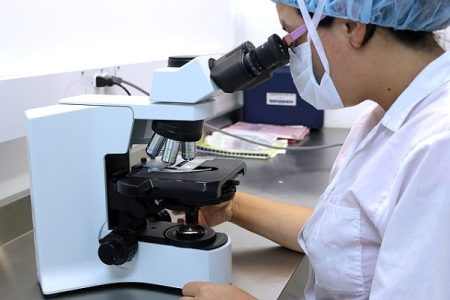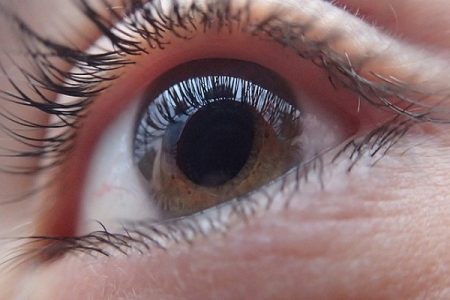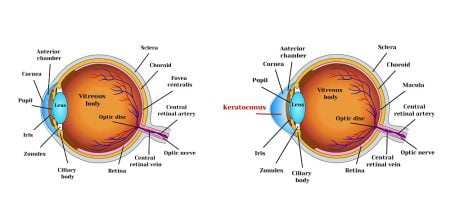What is Ishihara’s test?
Dr Shinobu Ishihara from Japan introduced the most popularly known color blindness test in 1917. The test is a color perception test for red-green color deficiencies.
The tests consist of a set of colored dotted plates (PseudoIsochromatic Plate or PIP), each of which shows certain numbers or patterns. This is the most widely used test for color vision deficiency and is used still by most ophthalmologists around the world. Though there are other color blindness tests also, but none of them is as widely used as the Ishihara test.
Ishihara color deficiency test instructions
Each of the plates 1 – 17 contains a number
Each of the plates 18 – 24 contains one or two wiggly lines.
Plates 1 and 24 are control tests. People who have normal vision and those who have any form of color blindness are generally able to identify the patterns on them.
In order to pass each test, you have to recognize the correct number the wiggly line on all the plates.
- Sit in front of the computer screen at approximately 75cm away. The circles should remain at eye levels.
- Avoid glares and bright lights in the room as they can alter the appearance of colors. Natural lights are preferred.
- Try to identity the number or the pattern on the circle within a few seconds such as five seconds
- As you identify the number or line, click on the circle
- The correct answer will appear on the screen
- Continue with the next plates till you complete all of the tests
However, it is important to note that this test does not guarantee complete accuracy. Several variables such as the glare on the screen, monitor brightness, and quality loss of online images may affect the original colors used in the test.
But, if based on these tests, you suspect color blindness, you should talk to a medical professional.
Ishihara test interpretation
Ishihara Color Blindness Test Plate 1
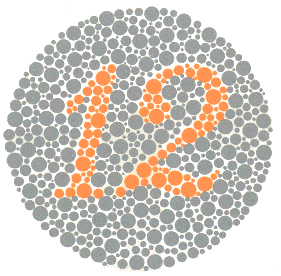 All people including color blind people should see a number 12.
All people including color blind people should see a number 12.
Ishihara Color Blindness Test Plate 2
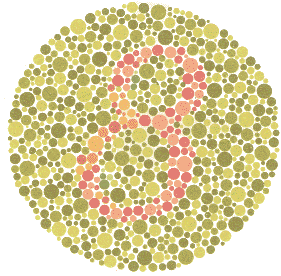
Those with normal color vision see an 8.
Those with red green color blindness see a 3.
Those with total color blindness see nothing.
Ishihara Color Blindness Test Plate 3
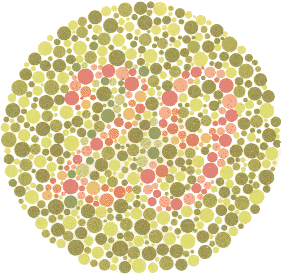
Those with normal color vision see a 29.
Those with red green color blindness see a 70.
Those with total color blindness see nothing.
Ishihara Color Blindness Test Plate 4
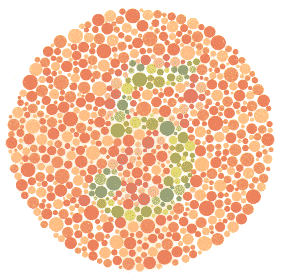
Those with normal color vision see a 5.
Those with red green color blindness see a 2.
Those with total color blindness see nothing.
Ishihara Color Blindness Test Plate 5
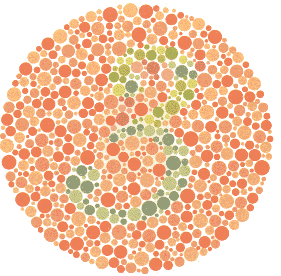
Those with normal color vision see a 3.
Those with red green color blindness see a 5.
Those with total color blindness see nothing.
Ishihara Color Blindness Test Plate 6
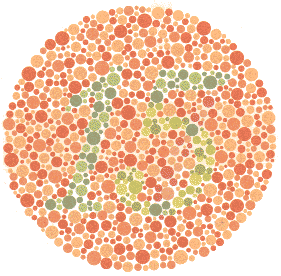 Those with normal color vision see a 15.
Those with normal color vision see a 15.
Those with red green color blindness see a 17.
Those with total color blindness see nothing.
Ishihara Color Blindness Test Plate 7
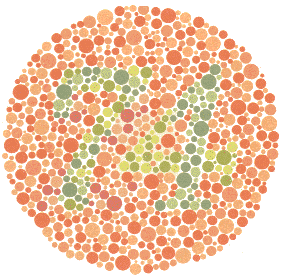
Those with normal color vision see a 74.
Those with red green color blindness see a 21.
Those with total color blindness see nothing.
Ishihara Color Blindness Test Plate 8
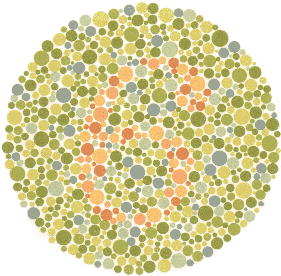
Those with normal color vision see a 6.
Most color blind people cannot see this number clearly.
Ishihara Color Blindness Test Plate 9
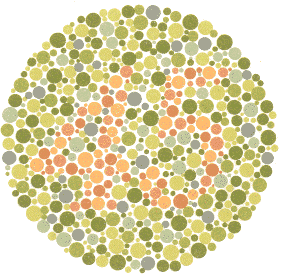
Those with normal color vision see a 45.
Most color blind people cannot see this number clearly.
Ishihara Color Blindness Test Plate 10
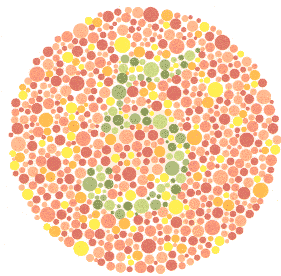
Those with normal color vision see a 5.
Most color blind people cannot see this number clearly.
Ishihara Color Blindness Test Plate 11
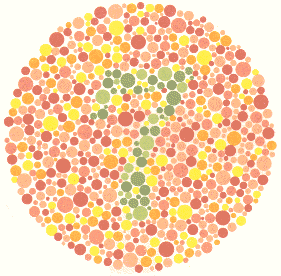
Those with normal color vision see a 7.
Most color blind people cannot see this number clearly.
Ishihara Color Blindness Test Plate 12
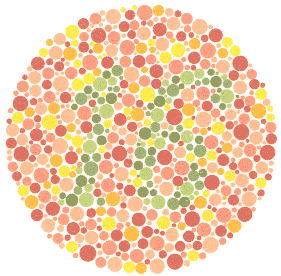
Those with normal color vision see a 16.
Most color blind people cannot see this number clearly.
Ishihara Color Blindness Test Plate 13
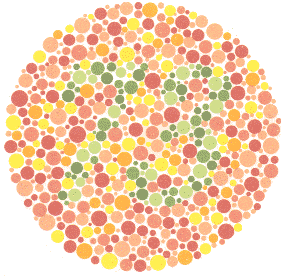
Those with normal color vision see a 73.
Most color blind people cannot see this number clearly.
Ishihara Color Blindness Test Plate 14
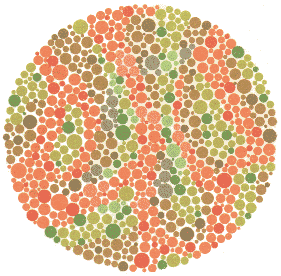
Those with normal vision or total color blindness are not able to see any number in this plate.
Those with red green color blindness see a 5.
Ishihara Color Blindness Test Plate 15
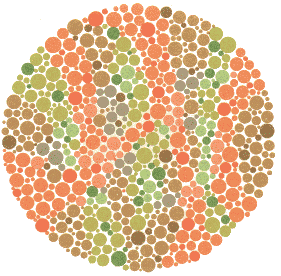
People with normal vision or total color blindness are not able to see any number.
Those with red green color blindness see a 45.
Ishihara Color Blindness Test Plate 16

Those with normal color vision see a 26.
Red color blind (protanopia) people will see a 6, mild red color blind people (prontanomaly) also see a 2 but faintly.
Green color blind (deuteranopia) people see a 2, mild green color blind people (deuteranomaly) also see a 6 but with difficulty and faintly.
Ishihara Color Blindness Test Plate 17
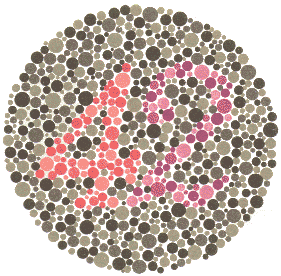
Those with normal color vision see a 42.
Red color blind (protanopia) people see a 2, mild red color blind people (prontanomaly) also see a 4, but faintly.
Green color blind (deuteranopia) people see a 4, mild green color blind people (deuteranomaly) may also see a number 2 but with difficulty and faintly.
Ishihara Color Blindness Test Plate 18
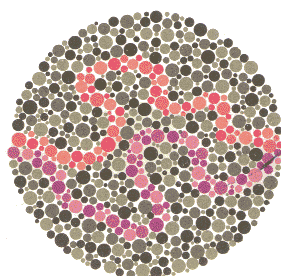
People with normal color vision are able to trace both the purple line and red line.
People with Protanopia (red colorblind) are able to trace the purple line, people with protanomaly (weak red vision) may be able to trace the red line with difficulty.
People with Deuteranopia (green color blind) are able to trace the red line, people with Deuteranomaly (weak green vision) may be able to trace the purple line with difficulty.
Ishihara Color Blindness Test Plate 19
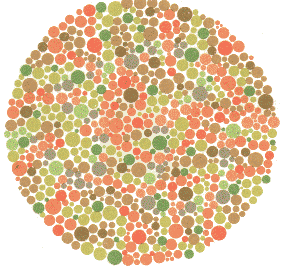
Those with normal color vision or total color blindness are unable to trace the line.
Most people with red green color blindness are able to trace the line, depending on the severity of their condition.
Ishihara Color Blindness Test Plate 20
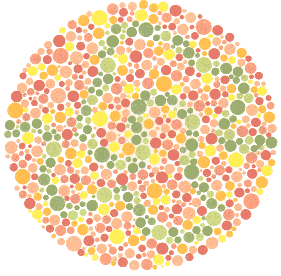
Those people who have normal color vision are able to trace a green line.
Most people with any form of color blindness are unable to trace any line.
Ishihara Color Blindness Test Plate 21
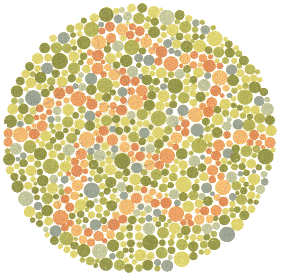
People who are with normal color vision are able to trace an orange line.
Most people with any form of color blindness are unable to trace the correct line.
Ishihara Color Blindness Test Plate 22

People who have normal color vision are able to trace the blue-green/yellow-green wiggly line.
Red green color blind people are able to trace the blue-green and red line.
Those who have total color blindness are not able to trace any line.
Ishihara Color Blindness Test Plate 23
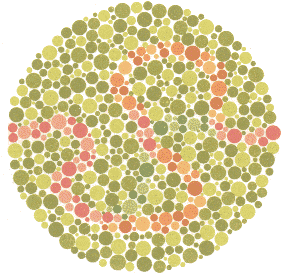
People with normal color vision are able to trace the red and orange lines.
People with red green color blindness are able to trace the red and blue-green lines.
People with total color blindness are not able to recognize any line.
Ishihara Color Blindness Test Plate 24
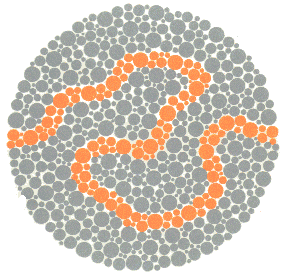
Everyone including color blind people are able to trace this pattern easily.




